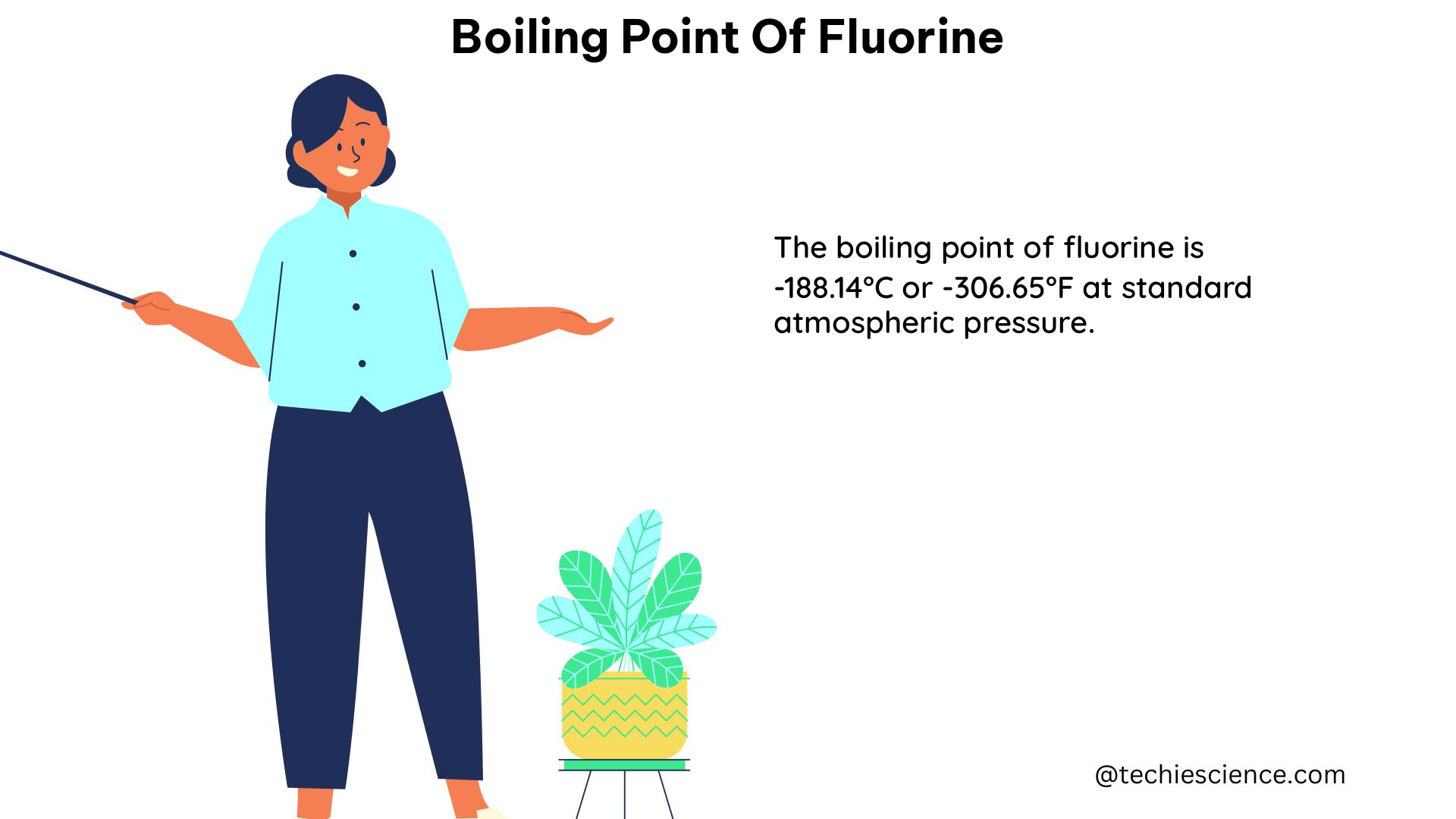The boiling point of fluorine, a highly reactive and corrosive element, is a crucial property that has significant implications in various scientific and industrial applications. At 85.03 Kelvin (-188.11 degrees Celsius or -306.60 degrees Fahrenheit) under standard atmospheric pressure (100 kPa), the boiling point of fluorine is relatively low compared to other halogens, yet it is higher than expected for a molecule of its size and weight due to the strong intermolecular forces between fluorine molecules.
Understanding the Boiling Point of Fluorine
The boiling point of a substance is the temperature at which the vapor pressure of the liquid equals the pressure surrounding the liquid, and bubbles of vapor form inside the liquid. This transition from liquid to gas phase is a crucial property that determines the behavior and applications of a substance.
The boiling point of fluorine can be calculated using the Clausius-Clapeyron equation, which relates the vapor pressure of a substance to its temperature:
ln(P2/P1) = (ΔHvap/R) * (1/T1 - 1/T2)
Where:
– P1 and P2 are the vapor pressures at temperatures T1 and T2, respectively
– ΔHvap is the enthalpy of vaporization
– R is the universal gas constant
Using this equation and the known values of the enthalpy of vaporization and vapor pressure of fluorine, the boiling point can be determined.
Factors Affecting the Boiling Point of Fluorine

The boiling point of fluorine is influenced by several factors, including:
-
Intermolecular Forces: Fluorine molecules exhibit strong intermolecular forces, particularly dipole-dipole interactions and London dispersion forces, which contribute to the relatively high boiling point compared to other halogens of similar size and weight.
-
Molecular Structure: Fluorine exists as diatomic molecules (F2) at room temperature, which have a higher boiling point than monatomic gases like helium or neon.
-
Electronegativity: Fluorine is the most electronegative element, with a Pauling electronegativity value of 3.98. This high electronegativity leads to the formation of strong covalent bonds and influences the intermolecular interactions.
-
Pressure: The boiling point of fluorine, like any substance, is affected by changes in pressure. As pressure increases, the boiling point also increases, as the vapor pressure of the liquid must equal the surrounding pressure for boiling to occur.
Comparison to Other Halogens and Water
Comparing the boiling points of the halogens, we can observe the following trend:
| Halogen | Boiling Point (K) |
|---|---|
| Fluorine (F2) | 85.03 |
| Chlorine (Cl2) | 239.11 |
| Bromine (Br2) | 332.17 |
| Iodine (I2) | 457.55 |
This trend shows that the boiling point increases with the atomic mass of the halogens, with fluorine having the lowest boiling point. However, the boiling point of fluorine is higher than expected based on this trend, due to the strong intermolecular forces mentioned earlier.
Interestingly, the boiling point of fluorine (85.03 K) is significantly lower than that of water (373.15 K), despite the fact that water molecules are much larger and have a higher molecular weight. This is because the hydrogen bonding in water molecules creates stronger intermolecular forces, leading to a higher boiling point.
Practical Applications and Considerations
The low boiling point of fluorine has several practical implications:
-
Cryogenic Applications: The low boiling point of fluorine makes it useful in cryogenic applications, such as the production of liquid fluorine for use in rocket propellants or as a coolant in specialized equipment.
-
Reactivity and Handling: The high reactivity and corrosive nature of fluorine require special handling and safety precautions when working with this element. Fluorine can react violently with many substances, including water, and can cause severe burns and respiratory damage.
-
Analytical Techniques: The unique physical and chemical properties of fluorine, including its low boiling point, make it a valuable tool in various analytical techniques, such as nuclear magnetic resonance (NMR) spectroscopy and mass spectrometry.
-
Industrial Applications: Fluorine and its compounds find applications in the production of fluoropolymers, pharmaceuticals, and various industrial processes, where its low boiling point and high reactivity can be exploited.
Conclusion
The boiling point of fluorine, at 85.03 Kelvin (-188.11 degrees Celsius or -306.60 degrees Fahrenheit) under standard atmospheric pressure, is a crucial property that reflects the unique characteristics of this highly reactive element. Understanding the factors that influence the boiling point, as well as the practical implications of this property, is essential for scientists, engineers, and researchers working with fluorine and its compounds.
References:
1. Lide, D. R. (2005). CRC Handbook of Chemistry and Physics (86th ed.). CRC Press.
2. Greenwood, N. N., & Earnshaw, A. (1997). Chemistry of the Elements (2nd ed.). Butterworth-Heinemann.
3. Atkins, P., & de Paula, J. (2014). Atkins’ Physical Chemistry (10th ed.). Oxford University Press.
4. Ramsay, W., & Travers, M. W. (1903). The Liquefaction of Fluorine. Proceedings of the Royal Society of London. Series A, Containing Papers of a Mathematical and Physical Character, 72(477), 81-85.
5. Pauling, L. (1960). The Nature of the Chemical Bond (3rd ed.). Cornell University Press.

The lambdageeks.com Core SME Team is a group of experienced subject matter experts from diverse scientific and technical fields including Physics, Chemistry, Technology,Electronics & Electrical Engineering, Automotive, Mechanical Engineering. Our team collaborates to create high-quality, well-researched articles on a wide range of science and technology topics for the lambdageeks.com website.
All Our Senior SME are having more than 7 Years of experience in the respective fields . They are either Working Industry Professionals or assocaited With different Universities. Refer Our Authors Page to get to know About our Core SMEs.